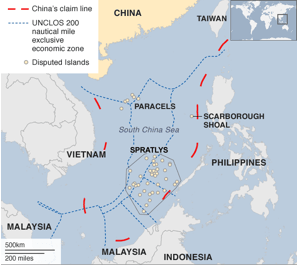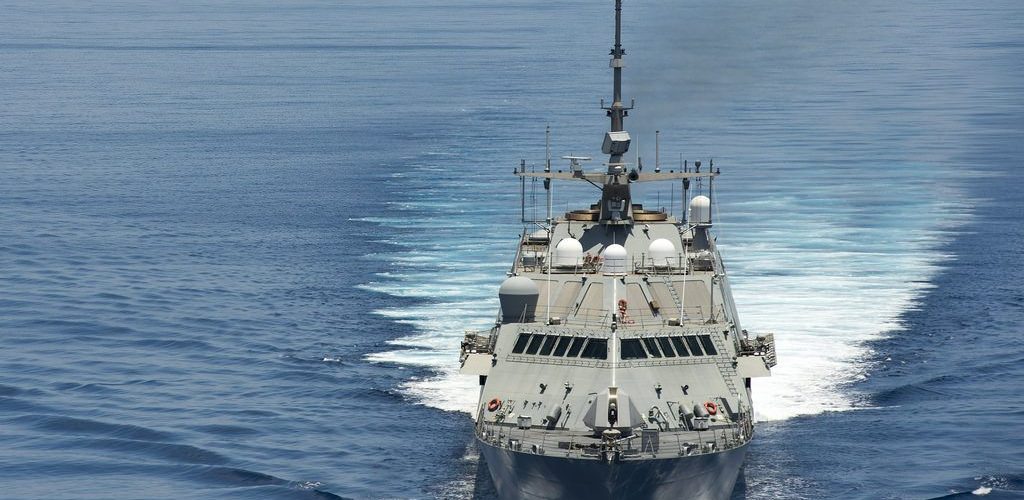“As is standard practice for China, when condemned by the US and UN for their actions, they took no notice of the ruling and ignored it..”
China will begin work this year on an environmental monitoring station on Scarborough Shoal in the South China Sea. Two US senators introduced a bill to impose sanctions on its activities in the disputed waterway.
China seized the Scarborough Shoal, which is also claimed by the Philippines, in 2012. The shoal is a sandbank or sandbar that makes the water shallow. The United States has warned—but done nothing else to curtail—Beijing against carrying out the same land reclamation work it has done in other parts of the South China Sea.
China claims the monitoring stations, along with docks and other infrastructure, form part of their island restoration and erosion prevention efforts planned for 2017.
Last June, US Defense Secretary Ash Carter warned China that any move to reclaim land at Scarborough Shoal would “result in actions being taken by the both United States and by others in the region. These actions have the effect of not only increasing tensions but isolating China.” Neither the US nor other nations took any action other than condemnation.
A report by the Asia Maritime Transparency Initiative (AMTI) stated that China is not only continuing to build these artificial islands in shoals and reefs but is increasing their efforts. The AMTI report was submitted just before a visit by US Secretary of State Rex Tillerson to Beijing. Secretary Tillerson is expected to reiterate US concern about Chinese island-building. Tillerson has called the activity “illegal.”
This week, US Senators Marco Rubio and Ben Cardin introduced the South China Sea and East China Sea Sanctions Act, which would ban visas for Chinese people helping to build South and East China Sea projects. The act will also sanction foreign financial bodies that “knowingly conduct or facilitate a significant financial transaction for sanctioned individuals and entities” if China steps up activity at Scarborough Shoal, among other actions. The bill is in the process of becoming law, has been read twice, and is now in the Foreign Relations Committee.
In reaction to the proposed act, Chinese Foreign Ministry spokeswoman Hua Chunying called the bill “extremely grating” and said it showed the “arrogance and ignorance” of the senators.
The AMTI, part of Washington’s Center for Strategic and International Studies, said the work on Fiery Cross, Subi, and Mischief Reefs in the Spratly Islands included naval, air, radar, and defensive facilities. Using satellite images taken this month, AMTI showed new radar antennae on Fiery Cross and Subi. The images showed that China has virtually completed major construction of military installations on the artificial islands it has built in the South China Sea. This expansion of control allows China to deploy combat planes and other military hardware in the region at any time. “So look for deployments shortly,” said AMTI director Greg Poling.
China’s Response to the AMTI Report
China denied US charges that it is militarizing the South China Sea, although last week Premier Li Keqiang said defense equipment had been placed on islands in the disputed waterway to maintain “freedom of navigation.”
Chinese Foreign Ministry spokeswoman Hua Chunying said on Tuesday she was unaware of the details of the AMTI report but added the Spratly Islands were China’s inherent territory. “As for China deploying or not deploying necessary territorial, defensive facilities on its territory, this is a matter that is within the scope of Chinese sovereignty,” she told a daily news briefing. In other words, China will do whatever China wants.
The US Response
Pentagon spokesman Commander Gary Ross declined to comment on the specifics of the AMTI report, saying it was not the Defense Department’s practice to comment on intelligence. Commander Ross did say that “China’s continued construction in the South China Sea is part of a growing body of evidence that they continue to take unilateral actions which are increasing tensions in the region and are counterproductive to the peaceful resolution of disputes.”
AMTI said China’s three air bases in the Spratly’s and another on Woody Island in the Paracel chain further north would allow its military aircraft to operate over nearly the entire South China Sea—a key global trade route mostly claimed by Beijing.
AMTI indicated that advanced surveillance and early warning radar facilities at Fiery Cross, Subi, and Cuarteron Reefs, as well as Woody Island, were complete. The AMTI went on to say that China installed HQ-9 surface-to-air missiles at Woody Island more than a year ago and deployed anti-ship cruise missiles at least once.
China has constructed hardened shelters with retractable roofs that are consistent with mobile missile launcher systems at Fiery Cross, Subi, and Mischief islands. On Fiery Cross, hangars for three larger planes such as bombers and 24 combat aircraft have been completed.
US officials told Reuters last month that China had finished building almost two dozen structures on Subi, Mischief, and Fiery Cross that appeared designed to house long-range surface-to-air missiles.
Competing Claims
Nation-states in the South China Sea region have competing claims over the ownership of the islands and seas in the area. These disputes have resulted in a history of skirmishes and limited military actions, which have resolved nothing. The South China Sea is widely seen as a potential regional flashpoint. China, Vietnam, the Philippines, Taiwan, Malaysia, and Brunei all have competing claims.

Largely uninhabited, the Paracels and the Spratly islands may have reserves of natural resources. There has been little geological exploration of the area, so estimates are extrapolated from the mineral wealth of adjacent areas. Besides the potential mineral and energy resources that may be present, the sea is also a major fishing area and shipping route.
China claims the largest portion of the territorial area defined by the “nine-dash line,” which stretches almost 500 hundred miles south and east from its most southerly province of Hainan.
Beijing contends that its ownership of the area goes back centuries to when the Paracel and Spratly island chains were regarded as integral parts of the Chinese nation. In 1947, China issued a map detailing its claims. The Chinese map showed the two island groups falling entirely within its territory. Those claims are mirrored by Taiwan.
Vietnam contends that China never claimed sovereignty over the islands before the 1940s. Vietnam says it has actively ruled over both the Paracels and the Spratly’s since the 17th century and has presented documentation that it claims proves this position.
The Philippines invokes its geographical proximity to the Spratly Islands as the primary basis of its claim of ownership over part of the grouping of islands and shoals.
Both the Philippines and China lay claim to the Scarborough Shoal (known as Huangyan Island in China), which sits a little more than 100 miles (160 km) from the Philippines and 500 miles from China.
Malaysia and Brunei also lay claim to territory in the South China Sea that they say is within their economic exclusion zones, as defined by the United Nations Convention on the Law of the Sea (UNCLOS).
Legal Actions
In 2013, the Phillipeans announced it would take China to an arbitration tribunal under the auspices of UNCLOS to challenge its claims. In July 2016, the tribunal backed the Philippines’ case, saying China had violated the Philippines’ sovereign rights.
As is standard practice for China, when condemned by the US and UN for their actions, they took no notice of the ruling and ignored it. China boycotted the UN proceedings, called the ruling “ill-founded,” and will not be bound by it.
A Stronger US Response is Possible
The US has conducted a series of what it calls Freedom of Navigation Operations (FONOP) in the South China Seas, raising tensions with Beijing. The Obama White House had faced off with Pacific Command, which wanted more frequent FONOPs in the area. With little response from the Obama administration, China continued to expand their construction in the disputed region.
With the new administration now in the White House, the Pacific Command said President Donald Trump had been presented with a “menu” of possible FONOPs, including evaluations of their advantages and drawbacks. How Trump exercises his judgment as commander-in-chief in the South China Sea about the Freedom of Navigation program will be of interest to both China and regional states alike.
There are fears that the area, which has had a long history of conflict, is becoming a flashpoint, with potentially serious global consequences involving the US and China. Unlike earlier conflicts when smaller states were involved and the potential for escalation was at a minimum, this time, with the US no longer taking a wait-and-see attitude, the stakes are high. A miscalculation or inadvertent action could cause an armed conflict to erupt in the region—something that no one wants.
Jon Harris is an OpsLens contributor and former Army NCO, civilian law enforcement officer, and defense contractor with over 30 years in the law enforcement community. He holds a B.S. in Government and Politics and an M.S. in Criminal Justice.
To contact or book OpsLens contributors on your program or utilize our staff for your story, contact [email protected].

















